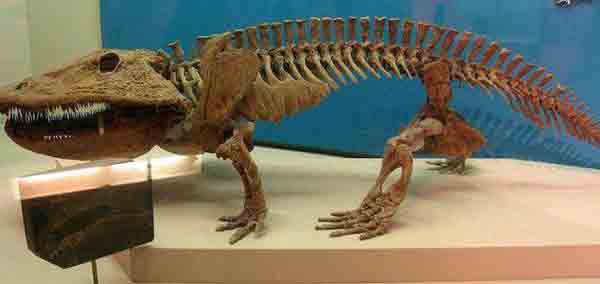Rare! Fossil Tooth Prehistoric Giant Amphibian mm 12 x 5 x 3 Metoposaurus diagnosticus Labyrinthodonts Extinct Temnospondyls Mesozoic Triassic Collecting Paleontology Museum.
Remarkable, rather large fossil specimen of an adult specimen, a finding that is difficult to find, considering that teeth of this size from Bull Canyon are difficult to obtain as they are not found very often, and larger teeth are very rare.
Representative fossil for collection and of excellent quality, with clear anterior and posterior details of the tooth surfaces and well-preserved enamel and extremities.
No restoration at all. Only a piece, as in photos.
The Metoposaurus (Gen. Metoposaurus), whose name means "anterior Lizard", is a large Extinct Amphibian Predator of the order Temnospondylia, suborder Stereospondylia, family Metoposauridae, lived in the upper Triassic (about 220 million years ago), when these animals have been progressively replaced by Reptiles.
His remains have been found in various parts of the world, including North America, Europe and North Africa. The metoposaurs and their closest relatives were therefore widely distributed and common throughout Laurasia during the late Triassic period. Among the stereospondyls, the metoposaurus seems to have been
one of the last survivors.
The appearance of this amphibian,
similar to a huge salamander, was really curious: the body was extremely wide and flat, as was the skull. The legs were relatively weak and very short, while the tail was robust. The skull, which covered about a third of the body's length, was quite elongated and had an exceptionally wide mouth opening, surrounded by
a multitude of thin, sharp teeth. The orbits were placed rather forward and in a slightly elevated position with respect to the rest of the skull. In general these animals were about a meter and a half long, but some large specimens could reach
three meters.

Adaptations of this type are indicative of the lifestyle of the metoposaurus: in all probability the animal spent most of its time
half submerged in the bottom of shallow and relatively calm waters, leaving its eyes protruding, waiting for some prey that passed nearby . As soon as a fish or small amphibian came into sight, the metoposaurus opened its enormous mouth. The suction of water created pushed the prey into the jaws of the metoposaurus.
A stiffening of the vertebral column, in the region of contact of the limbs, was apparently essential for swimming, with a condition that resembles that of the trunk of the plesiosaurs and, to some extent, the ichthyosaurs, which confirm the aquatic way of life. In fact, examining the vertebral column and the articulations of the limbs of Metoposaurus it was hypothesized that they used the limbs as fins and swam performing simultaneous and symmetric movements similar to the plesiosaurs.
A recent study in Poland suggests that the broad flat head, the wide flat bones of the limbs, the broad legs and the large tail of Metoposaurus diagnosticus are significant features that led researchers to conclude that they were swimming in ephemeral lakes during the season of rains and used the wide and flat head and the forearms to dig under the ground when the dry season began. Like all amphibians, he had lungs instead of gills and probably detected the vibrations of water to hunt. Like the Polmonate fish, perhaps it could cope with seasonal water shortages, entering a stage of life suspended in the dry mud of rivers.
Some fields, for example in Morocco, show an unusual accumulation of metoposaurus fossils, with many specimens piled on top of one another. Evidently these animals had gathered in a few pools of water in a period of extreme drought. When these puddles also dried up, metoposaurs found themselves dying in a narrow space, in a sort of "common grave". The sediments then covered the carcasses quickly enough to allow optimal conservation of the remains.
The exact predators of Metoposaurus are unknown, but the phytosaurs have been found to be closely associated in the beds of the bones.
In recent years the metoposaurus has been the subject of a heavy reclassification by paleontologists, and many forms previously ascribed to this genus have been redescribed as belonging to other genera: so the smaller North American specimens were classified in the genus Apachesaurus, while those larger in the genus Koskinonodon (formerly known as Buettneria); the aforementioned Moroccan form, on the other hand, is now known as Dutuitosaurus ouazzoui. However, there is no common view of the classification of metoposaurs. At present the metaphorosa taxonomy was based on the position of the lacrimal bone. In any case, these animals all belong to the same family (Metoposauridae) within the stereospondile, a group of amphibians with distinctly aquatic characteristics.



